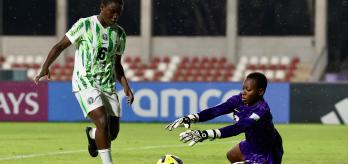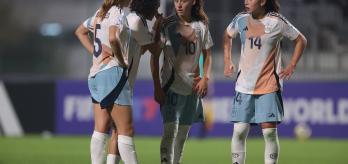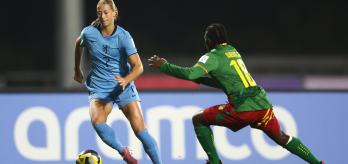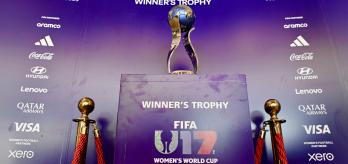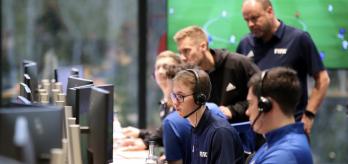As a goalkeeper, managing the space between yourself and the defensive line becomes a vital consideration when out of possession. In this article, Technical Study Group Lead Pascal Zuberbühler explains the different aspects goalkeepers need to consider in their positioning and timing when dealing with balls played in behind the defensive line, as seen on display at the FIFA U-17 Women’s World Cup Morocco 2025™.
Parameters when facing balls in behind
The modern goalkeeper is often associated with holding a high line when their team is in possession high up the field. However, the situation is more nuanced when out of possession, especially when defending balls in behind, where the ball is travelling towards you. Zuberbühler, who is also a FIFA Senior Goalkeeping Expert, has previously explained three key parameters goalkeepers need to consider when intervening in these moments of the game:
-
The trajectory of the ball.
-
The positioning of their defenders.
-
The positioning of the attacking player.
Examples of strong interventions from Morocco
Below are three examples of goalkeepers successfully sniffing out threats from balls played in the space between themselves and their defensive line. In all three clips, the goalkeepers involved exhibit strong game understanding leading up to the intervention by assessing where the ball, team-mates and opponent are. They then use their technical ability to deal with the situation. The first clip is particularly special, featuring three consecutive examples of goalkeepers successfully dealing with balls in behind in the space of 24 seconds.
Clip 1: Cameroon’s Jessica Mabou v. Netherlands’ Meren Groothoff
Zuberbühler unpacks the clip:
“It starts with a fantastic through-ball from the Netherlands. While the ball is travelling, Cameroon goalkeeper Mabou comes from a deeper position – she was not high up. Instead, she reads the trajectory of the ball before clearing the danger.
“Crucially, before intervening, Mabou notices clearly that her defender was blocking the opponent’s run. The defender understood that her goalkeeper would come, so she should focus on the opponent instead. The goalkeeper and defender worked very well together – something you don’t see all the time in football. In the daily training session, you need to have goalkeepers involved with the team to work on this.”
“You have to see correctly whether it’s a situation where I have to defend the zone, come out or leave the defender do the work.”
Mabou clears the ball, and it ends up bypassing all outfield players, in behind the Netherlands’ backline. Now, it’s Groothoff’s turn to manage the space between herself and her defensive line.
“The ball lands on the Netherlands’ right side of the pitch. Groothoff needs to run a long way to get to the ball, and takes a big risk to make this tackle, but she executes it brilliantly. For this, she had to assess the situation and be on point and ready. She then follows up with a long ball back, deep inside Cameroon’s half.
“The Cameroon defender is behind the Netherlands’ attacker, so Mabou needs to come out. She was cool and calm, and when she intervened, she decided to dribble around the attacker with a nice first touch. It looks very easy in this situation, but the first touch is crucial if you come outside the box. She did this amazingly, and then played around the opponent to her team-mate. This is a series of fantastic actions from these two goalkeepers.”
Clip 2: Korea DPR’s Kim Son Gyong v. Mexico
“In this example, Korea DPR lose the ball very high up, and you can see the amount of space in behind. The goalkeeper, Kim, was really on the line, not waiting and going around. She was reading the trajectory precisely and came straight to the ball, taking full risk. She came with determination: ‘This is my ball’. Look at the striker; she wasn’t in the mood to keep her legs in the challenge, partly because Kim was very clearly coming to intervene. It’s a beautiful clearance coming from a deeper starting position.”
Clip 3: Ecuador’s Maria Rodriguez v. Norway
“This clip starts with another good through-ball in behind. The Ecuador centre-back is out of the equation. It was clear to the goalkeeper, Rodriguez, that she needed to come out, as the ball was very close. Also, you must make a decision here: are you waiting inside the penalty area to claim the ball? Here, it’s a close call. She takes no risk, and with her right foot, she came out and cleared the ball with her feet.
“She avoided trying to keep the ball in play, which meant a more convincing clearance – a good decision-making move. Like in the example with Kim, Rodriguez came from a deeper position instead of being 20m further up the pitch. She used her game understanding to first read the through pass, and she did this brilliantly.”
Developing the goalkeeper-defender connection
Each of the examples above showcased a strong understanding between the goalkeeper and their team-mates. This connection requires team-level development over time – a process which implies goalkeepers training together with the rest of their team, explains Zuberbühler.
“If a defender is taken out of the game by a ball in behind, and the opposition attacker is 1v1 with the goalkeeper, the defender needs to know whether their goalkeeper comes out or not. Then, the defender knows that they need to run to the goal line, like in the third clip, in anticipation of the goalkeeper not reaching the ball.”
“The connection between the goalkeeper and defender is crucial. Every day in the training, the team needs to understand when the goalkeeper does or does not come out.”
“In addition, they need to know if she’s able to pass around, like the Cameroon goalkeeper’s situation. The defender gave up already, as she knew her keeper was coming. She could offer herself as the extra numerical player in this situation. I’d like to see this a little bit more: the awareness between goalkeepers and defenders. This is something about game intelligence and reading the situation correctly. You need to have a big picture.”
Summary
-
Goalkeepers and defenders must be able to recognise quickly when their team is in or out of possession. Then, they can adjust their positioning accordingly.
-
Forming a game understanding is the priority when dealing with balls played in behind the defensive line. They should observe where the ball is, where team-mates are, and where the opposition attackers are before intervening.
-
Outfield players need to understand the qualities of their goalkeeper so they can position themselves more effectively when the goalkeeper intervenes.
- Coaches need to regularly include goalkeepers as part of the wider team’s training to develop this integral understanding between them and their outfield players.




